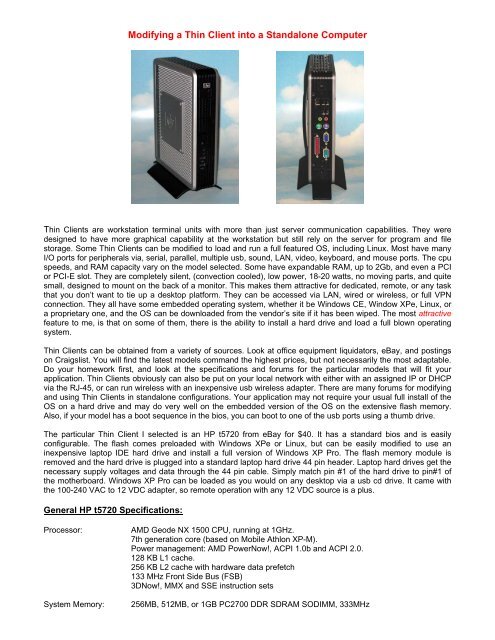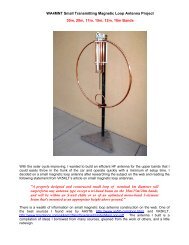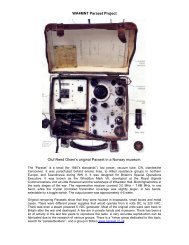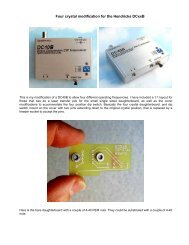Modifying a Thin Client into a Standalone Computer - QRPBuilder.com
Modifying a Thin Client into a Standalone Computer - QRPBuilder.com
Modifying a Thin Client into a Standalone Computer - QRPBuilder.com
You also want an ePaper? Increase the reach of your titles
YUMPU automatically turns print PDFs into web optimized ePapers that Google loves.
<strong>Modifying</strong> a <strong>Thin</strong> <strong>Client</strong> <strong>into</strong> a <strong>Standalone</strong> <strong>Computer</strong><br />
<strong>Thin</strong> <strong>Client</strong>s are workstation terminal units with more than just server <strong>com</strong>munication capabilities. They were<br />
designed to have more graphical capability at the workstation but still rely on the server for program and file<br />
storage. Some <strong>Thin</strong> <strong>Client</strong>s can be modified to load and run a full featured OS, including Linux. Most have many<br />
I/O ports for peripherals via, serial, parallel, multiple usb, sound, LAN, video, keyboard, and mouse ports. The cpu<br />
speeds, and RAM capacity vary on the model selected. Some have expandable RAM, up to 2Gb, and even a PCI<br />
or PCI-E slot. They are <strong>com</strong>pletely silent, (convection cooled), low power, 18-20 watts, no moving parts, and quite<br />
small, designed to mount on the back of a monitor. This makes them attractive for dedicated, remote, or any task<br />
that you don’t want to tie up a desktop platform. They can be accessed via LAN, wired or wireless, or full VPN<br />
connection. They all have some embedded operating system, whether it be Windows CE, Window XPe, Linux, or<br />
a proprietary one, and the OS can be downloaded from the vendor’s site if it has been wiped. The most attractive<br />
feature to me, is that on some of them, there is the ability to install a hard drive and load a full blown operating<br />
system.<br />
<strong>Thin</strong> <strong>Client</strong>s can be obtained from a variety of sources. Look at office equipment liquidators, eBay, and postings<br />
on Craigslist. You will find the latest models <strong>com</strong>mand the highest prices, but not necessarily the most adaptable.<br />
Do your homework first, and look at the specifications and forums for the particular models that will fit your<br />
application. <strong>Thin</strong> <strong>Client</strong>s obviously can also be put on your local network with either with an assigned IP or DHCP<br />
via the RJ-45, or can run wireless with an inexpensive usb wireless adapter. There are many forums for modifying<br />
and using <strong>Thin</strong> <strong>Client</strong>s in standalone configurations. Your application may not require your usual full install of the<br />
OS on a hard drive and may do very well on the embedded version of the OS on the extensive flash memory.<br />
Also, if your model has a boot sequence in the bios, you can boot to one of the usb ports using a thumb drive.<br />
The particular <strong>Thin</strong> <strong>Client</strong> I selected is an HP t5720 from eBay for $40. It has a standard bios and is easily<br />
configurable. The flash <strong>com</strong>es preloaded with Windows XPe or Linux, but can be easily modified to use an<br />
inexpensive laptop IDE hard drive and install a full version of Windows XP Pro. The flash memory module is<br />
removed and the hard drive is plugged <strong>into</strong> a standard laptop hard drive 44 pin header. Laptop hard drives get the<br />
necessary supply voltages and data through the 44 pin cable. Simply match pin #1 of the hard drive to pin#1 of<br />
the motherboard. Windows XP Pro can be loaded as you would on any desktop via a usb cd drive. It came with<br />
the 100-240 VAC to 12 VDC adapter, so remote operation with any 12 VDC source is a plus.<br />
General HP t5720 Specifications:<br />
Processor: AMD Geode NX 1500 CPU, running at 1GHz.<br />
7th generation core (based on Mobile Athlon XP-M).<br />
Power management: AMD PowerNow!, ACPI 1.0b and ACPI 2.0.<br />
128 KB L1 cache.<br />
256 KB L2 cache with hardware data prefetch<br />
133 MHz Front Side Bus (FSB)<br />
3DNow!, MMX and SSE instruction sets<br />
System Memory: 256MB, 512MB, or 1GB PC2700 DDR SDRAM SODIMM, 333MHz
Flash Memory: 1GB or 512MB (remove for hard drive modification)<br />
Video: Video SiS741 GX Integrated, 2048 x 1536 max resolution, 32bit@60 Hz<br />
USB ports: Six USB 2.0 ports (2 front / 4 rear)<br />
Serial/Parallel: 1 Serial / 1 Parallel<br />
PS/2 ports: 2 PS/2 (keyboard and mouse)<br />
Audio: 16 bit stereo, 44 KHz sample rate (1/8” input and 1/8” output jacks), and<br />
built-in speaker.<br />
Networking: 10/100 BaseT Fast Ethernet, RJ-45<br />
VPN Connection through MS Point-to-Point<br />
Wake on LAN<br />
PCI Expansion: 1 slot<br />
Power Supply 100-240VAC 50/60 Hz, to 12 VDC, 3.3 A adapter<br />
Dimensions: 9.85”H x 8.09”D x 2.59”THK., Weight 3.7 lbs.<br />
As received, with the cover removed…
512 MB Flash Memory module 44pin header underneath the flash, after removal<br />
I modified my HP t5720 by upgrading the motherboard BIOS from the HP site to v1.12a via bootable usb thumb<br />
drive, installed a surplus 2.5” 80GB IDE hard drive, and with a little creative fitting it mounts nicely inside the<br />
case. After a full install of Windows XP Pro with SP3, and a upgrade to 1GB RAM, I have a fully functional, quiet,<br />
mini-desktop.<br />
Ken - WA4MNT<br />
www.qrpbuilder.<strong>com</strong><br />
E-mail – kloc@swiftwireless.<strong>com</strong>





